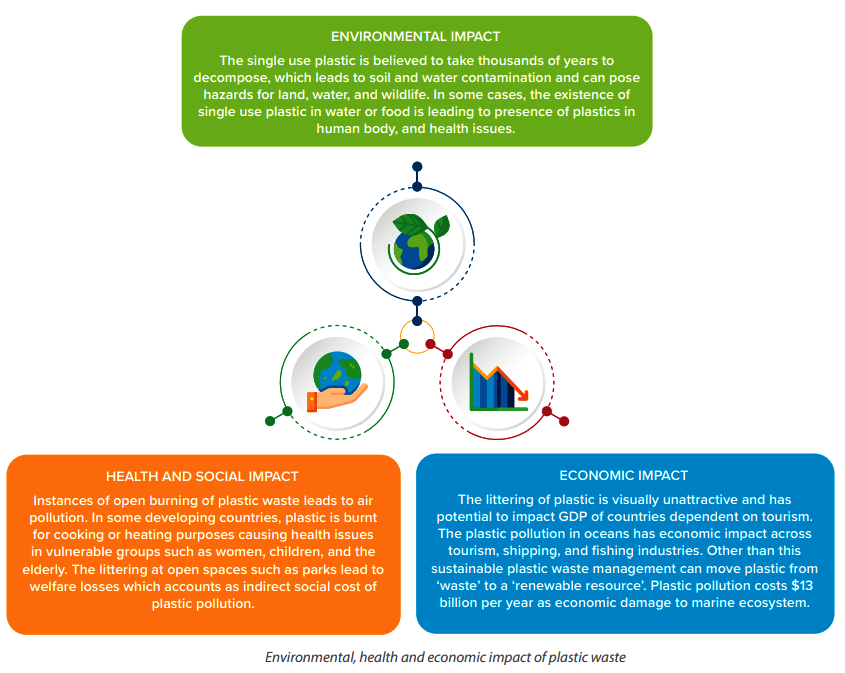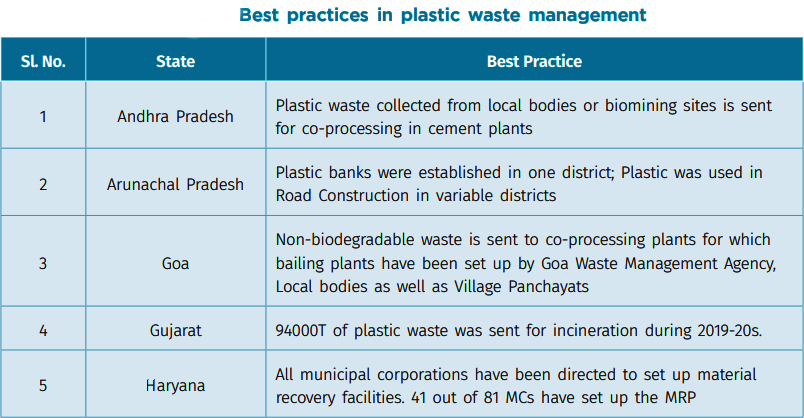Biodiversity & Environment
Plastic Waste Minimisation: NITI Aayog
- 06 Jul 2022
- 6 min read
For Prelims: Single Use Plastics and its uses, Extended Producer Responsibility (EPR)
For Mains: Need for alternatives of Single use plastics, Plastic Waste Management (Amendment) Rules, 2022
Why in News?
Recently, NITI Aayog has releases a report titled ‘Alternative Products and Technologies to Plastics and their Applications’ to encourage use of alternatives of plastics.
- The Ministry of Environment, Forest and Climate Change has also banned Single Used Plastics (SUP), violation of the ban will invite punitive action under Section 15 of the Environment Protection Act (EPA).
What are the Findings of the Report?
- Global Plastic Production and Disposal: Between 1950–2015, the cumulative production of polymers, synthetic fibre and additives was 8,300 Million Tonnes (MT), of which 55% went straight to landfills or were discarded, 8% incinerated, and only 6% were recycled.
- By 2050 if production is continued at the same rate, it would generate 12,000 MT.
- India’s Case: India produced 3.47 million tonnes of plastics waste per Annum, with the per capita waste growing from 700 grams to 2,500 grams over the last five years.
- Goa, Delhi & Kerala have reported the highest per capita plastic waste generation, while Nagaland, Sikkim and Tripura have reported the lowest per capita plastic waste generation.
- Concern: Globally, 97-99% of these plastics are derived from fossil fuel feedstock while the remaining 1-3% come from bio (plant) based plastics.
- Only a small amount of this plastic waste gets recycled, adding that a majority of this waste leaks into the environment through various polluting pathways.
- India collects only 60% of its plastic waste with the rest 40% remaining uncollected and enters the environment directly as waste.
- Nearly every piece of plastic begins as a fossil fuel, and greenhouse gases (GHG) are emitted at each stage of the plastic lifecycle: a) fossil fuel extraction and transport, b) plastic refining and manufacture, c) managing plastic waste, and d) ongoing effects within oceans, waterways, and various ecosystem landscapes.
What are the Recommendations?
- The most preferred option for the management of waste is waste minimisation. Strengthen the waste minimisation drive through Extended Producer Responsibility (EPR), proper labelling and collection of compostable and biodegradable plastics, while relaxing the deadline for adoption of biodegradable plastic.
- Develop emerging technologies, e.g., additives can make plastics biodegradable polyolefins, such as polypropylene and polyethylene
- Use of Bio-plastics: as a cost-effective alternative to plastics.
- Encourage R&D (Research and Development) and incentivize the manufacturing sector.
- Enhance transparency in disclosing waste generation, collection, recycling or scientific disposal to bring accountability and avoid greenwashing.
- Greenwashing is the process of conveying misleading information about how a company’s products are more environmentally sound.
What can be the Alternatives to Plastics?
- Glass:
- Glass has always been the safest and the most viable option for the packaging and use of food and liquid.
- Glass can be recycled multiple times, so it doesn't have to end up in landfills. It is cost-effective, considering its durability and recyclability.
- Bagasse:
- Compostable, eco-friendly bagasse can replace plastic needing as disposable plates, cups or takeout boxes.
- Bagasse is made from the pulp that is leftover when the juice is extracted from sugarcane or beets. It can be used for other purposes, such as a biofuel.
- Bioplastics:
- Plant-based plastics, known as bioplastics, have been hailed as a green alternative to fossil fuel-based plastic, especially when it comes to food packaging.
- But bioplastics have their own environmental footprint, requiring the growing of crops and therefore land and water use.
- Bioplastics have been shown to be just as harmful, and in some cases more harmful, than conventional plastic.
- Natural Textiles:
- When it comes to replacing polyester and nylon clothing which shed millions of tiny plastic fibres with every single wash, the traditional alternatives are cotton, wool, linen and hemp.
- But the production of cotton has been causing serious threats to the environment and also comes at a human cost.
- When it comes to replacing polyester and nylon clothing which shed millions of tiny plastic fibres with every single wash, the traditional alternatives are cotton, wool, linen and hemp.
- Refill, reuse and buy unpackaged:
- By far the least damaging type of packaging is one that can be used again and again, or none at all.
- Reusable fabric bags for fruit & veg etc.
- Reusable containers and boxes for meat, fish, cheese etc.
- Refillable bottles and jars for oil & vinegar, cleaning liquids etc.
- Beeswax wraps instead of foil and clingfilm.
- By far the least damaging type of packaging is one that can be used again and again, or none at all.








